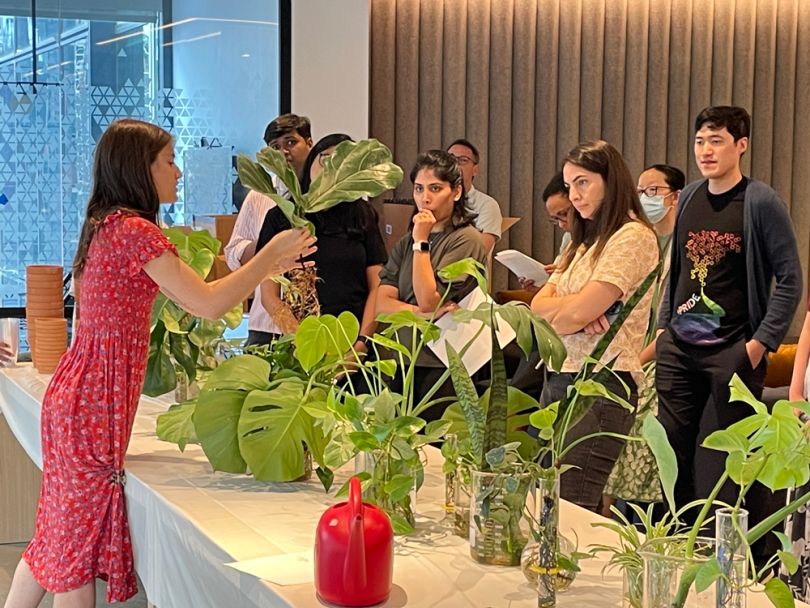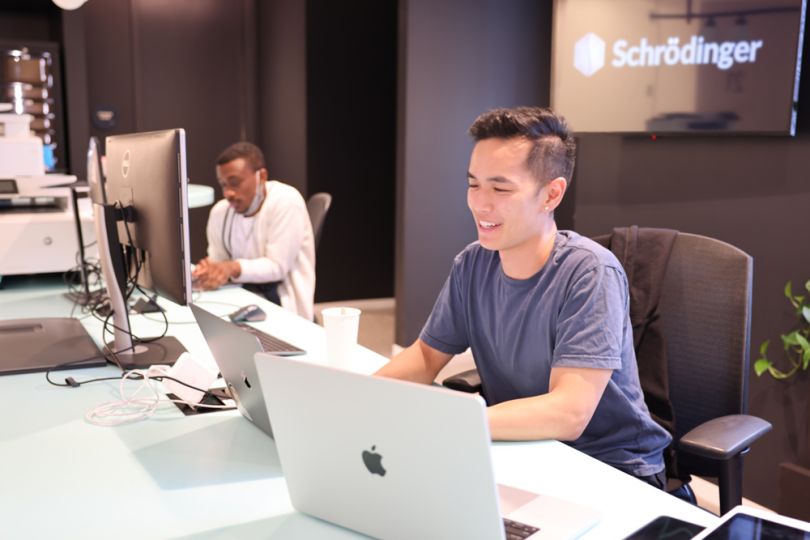Toward the end of her PhD career, Director of Education Jenny Chambers was at a loss. In graduate school, she had a front row seat to work-life balance as a young faculty member; she’d also just had her first baby. Chambers never gave up her love of teaching, but she couldn’t see herself spending her life in an academic lab.
Senior Scientist Kat Bay, equipped with a degree in computational organic chemistry, confronted the same crucible out of college. As a then-assistant professor of organic chemistry during the pandemic, she was forced to teach one of the most complex curriculums in a virtual setting — a sea of black webcam boxes awaited her, swallowing up any viable educational engagement. Bay stood before the same crossroads as Chambers, her love of education conflicting with the need for a sustainable career.
As an undergrad in a psychology class, Education Specialist Abi Emtage’s career calculus changed upon seeing a 3D video presentation of neurotransmitters. The way molecules bind to proteins on a visible scale mesmerized her, and it translated to a PhD in computational and medicinal chemistry, as well as an illustrious five-year career as a pharmacy professor. Her next step would see her apply education in a more far-reaching role.
Three disparate career paths, similar but distinct, came together at Schrödinger, a biotech company that offers enterprise software and molecular simulations for pharmaceutical and materials science research, development and education.
“I’m working with Abi and Kat to focus on teaching people — whether they’re from a scientific background, are a high school student or a developer — how they can use the software for specific research focus,” Director of Education Chambers explained. “We want to highlight that if you want to learn science, this is a great way to do it.”
In her previous lab work, Chambers was introduced to Schrödinger’s software and interacted with people at the company. Before long, she realized it was her ideal place of employment, a strong work culture backed by a foundation of biotech stability and educational priorities.
“If you want to learn science, Schrödinger is a great way to do it.”
“I love that I now do my science on a computer,” she said enthusiastically. “When I was in a lab, I had to be in. But now, I’m able to work flexibly.”
Bay, the company’s academic curriculum designer, and Emtage, an education specialist focused on maintaining educational materials and best practices for the software, had similar revelations when it came to working at Schrödinger. Bay saw a role that allowed her to blend skills in teaching and computational science — her job involved generating educational materials and training teachers that use Schrödinger’s software.
“Not a lot of companies have an education team,” Bay said, noting the niche nature of interfacing between the academic and industry sides of biotechnology.
Emtage, coming off a teaching stint, hoped to imbue the same fascination with 3D models upon others using Schrödinger’s software, along with her philosophy of platforming the importance of molecular visualization in science. “A role came up that checked a lot of these boxes,” she recalled. “For both my computational research background as well as the passion for teaching and education.”
The common thread? Schrödinger’s mission of providing a platform for scientific research across academic institutions and private companies, founded on the basis of cutting-edge software that highlights education as a pillar of industry.
Graduating Class
Schrödinger’s computational platform powers material design, molecular modeling and drug discovery for use in research. Adopted by private companies and educational institutions across industries, the company’s software facilitates the missions of a diverse customer base. For its educational endeavors, the team is also proud of its curriculum’s reach. From elementary school up to graduate programs, Schrödinger’s online courses are used extensively in academia. It’s also exciting for team members to see alumni that have gone through the course return for more. There are even validating instances of Schrödinger applicants with online course certification on their resumes.

Visualizing Scientific Success and Influence
Being able to visualize rather abstract concepts is a cornerstone to scientific education. Just ask David Goodsell, an artist who specializes in scientific illustrations.
“Anyone in the field of biology or chemistry is familiar with his watercolor paintings,” said Emtage. “I’ve been a fan for years, and I got to be in the lineup at a speaker event with him.”
Emtage’s work on the Schrödinger team earned her a spot at Columbia University’s Visualizing Science Webinar, where she got to show the world how the company’s software opens doors for both artists and scientists to generate images that serve versatile purposes.
As an expert in software-based biochemistry, the public event validated years of her inspiration for the subject and the formative parts of her career. 3D modeling and visualization enabled her career advancement in both research and understanding complex questions. With her role curating online documentation, courses and teaching materials, she hopes to do her part in distributing such empowerment to others interested in science, technology, engineering and math fields.
“Seeing students have that ‘aha’ moment of getting to play around with a 3D structure of a protein and a drug molecule during computational modeling workshops where it all clicks together — that was something that I was really passionate about,” Emtage said.
The Seeds of STEM
During an outreach event, Bay and her colleague visited a second-grade class, where they unveiled the chemistry behind the kids’ favorite gooey material – slime.
“We were able to run molecular dynamic simulations of all these molecules coming together as you add more water,” Bay outlined. “The kids loved it, because they made slime and can now connect all of the science behind it.”
Hosting community events at schools from elementary up to the graduate level is core to Schrödinger’s mission. Seeding the initial seeds of STEM interest is vital for cultivating research passion within the future generation, and this long-term foresight informs much of the company’s policies — and resonates with its employees’ sense of purpose.
Eventually, the ripple effect of initiating interest in science leads to innovations in the types of projects and events the education team can develop.
“You can extract DNA from strawberries with home ingredients,” Chambers recalled of another experiment. “With dish soap, rubbing alcohol and cold water, we can pretend to shrink ourselves down and look right at these molecules we pulled out.”

DEIA In STEM
At its core, education isn’t just about what is taught, but who gets to receive it. A career in STEM can unlock doors for kids, but many don’t have the privilege of such exposure — Schrödinger wants to change that. “We’re applying for a National Science Foundation grant with a CUNY school,” said Bay. “The funding will provide software for underrepresented students who might not have the tools necessary to enter the workforce, with the hopes that it will increase diversity within the computational chemistry field.”
The Circle of Education
In 2018, while thinking of ways to reach underrepresented groups in STEM, the education team learned of a school system where, once a week, a student would participate in work placement to broaden their personal and professional horizons.
This program inspired Schrödinger to accept an intern from Cristo Rey High School who was looking to learn more about computational science. Remy, a senior at the time, spent his last semester with the education team. Now, he’s back for another position with the live design development team, hoping to join the Schrödinger crew one of these days. These are the types of validating stories that nourish the team, seeing the payoff — even years later — of educational investment.
And who knows, one day Remy might very well join the Schrödinger team, learning the same curriculum — its suite of lesson plans, online courses and best practices — that are tailored to customers, educators and students. To develop and promote software products, it’s important for those behind the innovative tech to study the material.
“Folks who are joining our company for the first time, who might not have had exposure to computational chemistry or biology before can get up to speed because all of the same tools we generate for customers are used internally,” Bay said.








